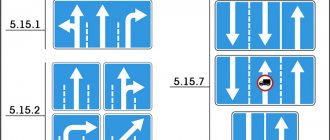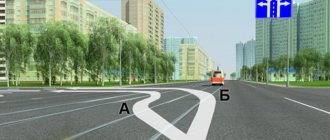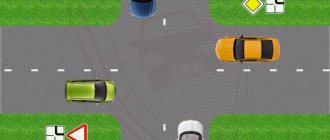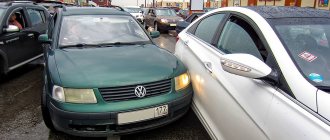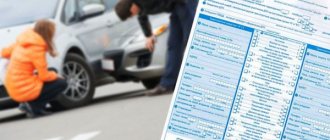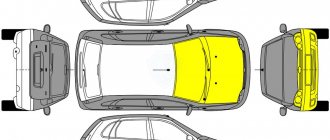Home/Registration of an accident/When turning left
Maneuvering is considered a difficult aspect of road traffic. Moreover, even experienced drivers can break the rules when turning left. This is fraught with fines and sanctions from the traffic police. Traffic rules are aimed at minimizing the risk of accidents when turning left. Therefore, the driver must know the traffic rules and comply with the established norms.
Traffic regulations when turning left with comments
The general rules for making a left turn are enshrined in Section 8 of the Traffic Regulations of the Russian Federation. It is important to comply with the following standards:
Attention! If you have any questions, you can chat for free with a lawyer at the bottom of the screen or call Moscow; Saint Petersburg; Free call for all of Russia.
The left turn maneuver near tram tracks is permitted if the driver does not create an obstacle to the passage of railway transport (clause 8.5 of the Russian Traffic Regulations).- When turning left, you need to take the extreme left position (clause 8.5 of the Russian Traffic Regulations).
- It is necessary to turn in such a way that when leaving the intersection of roadways the car does not end up on the side of oncoming traffic (clause 8.6 of the Russian Traffic Regulations).
- If the paths of cars intersect, and the order of movement is not stipulated by current legislation, the driver of the vehicle approaching from the right is obliged to give way (clause 8.9 of the Russian Traffic Regulations).
1) For those who turn left.
If you plan to make a left turn in order to avoid an accident, you must be guided by the provisions of Section 8 of the Traffic Regulations of the Russian Federation. Current legislation requires:
- Notify other road users about the planned maneuver. To do this, you need to turn on the turn signal (clause 8.5 of the Russian Traffic Regulations). If it is missing or faulty, giving a signal using your hand is acceptable. The citizen must indicate in advance the direction in which he intends to turn. Moreover, it is necessary to try to ensure that other road users notice the signal. Turn off the turn signals only after the maneuver is completed.
- The driver must not interfere with other road users or create the risk of an accident when turning left.
- The driver is obliged to give way to a tram in the same direction and to oncoming vehicles (clause 8.8 of the Russian Traffic Regulations).
- The maneuver must be performed from the extreme left position. However, if the width of the roadway does not allow the action to be carried out, a U-turn or turn from the right shoulder is allowed. In this case, you need to let oncoming and passing cars pass (clause 8.8 of the Russian Traffic Regulations).
- Giving a signal to turn left does not give the citizen any advantage over other road users.
2) For those who overtake.
First of all, the driver is obliged to follow the general rules for overtaking. They are reflected in section 11 of the Traffic Regulations of the Russian Federation. Paragraph 11.1 states that overtaking can only be done if there is a free lane on the road. The maneuver should not lead to emergency situations or create interference for other road users. If the car ahead has already given a signal to turn left, overtaking is strictly prohibited (clause 11.2 of the Russian Traffic Regulations). The maneuver cannot be performed in a number of other cases. They are reflected in paragraphs 11.2 and 11.4 of the Russian Traffic Regulations. Overtaking is prohibited:
- at a pedestrian crossing;
- at a railway crossing and 100 m before it;
- in an area where visibility is severely limited;
- at controlled intersections;
- at intersections with unregulated traffic when driving on a secondary road;
- in tunnels, on bridges, overpasses, overpasses;
- if the car moving ahead began to avoid the obstacle and gave a corresponding signal;
- if the car moving behind begins to overtake.
What do you need to know to avoid making such mistakes?
The driver who started the left turn maneuver.
- Carefully study the situation when starting the maneuver. You should not rely only on the rearview mirrors - when intending to turn, you need to briefly turn your head to the left and assess the situation. Rearview mirrors will not provide complete information due to the existing blind spots found in any car.
- Even if overtaking is prohibited in principle in a given zone, it would still be useful to make sure that there is no violating car.
- If a car is overtaking behind you, it is better to give way to it and then calmly turn.
Driver overtaking
- Despite the fact that overtaking is not prohibited at an uncontrolled intersection, it is still undesirable to perform such maneuvers. Even when driving on the main road.
- If you nevertheless decide to overtake at an intersection with no regulation, then first soberly assess the situation and your capabilities, and only then make a decision.
- Do not forget that the situation on the road with moving vehicles is constantly changing. Therefore, in order to make the right decision, you need to keep as many cars moving in front and behind in your field of vision as possible - and only then start overtaking.
Important! According to the provisions of the traffic rules, a driver making a left turn must necessarily give way to vehicles that, when driving on an equivalent road, are heading straight along the oncoming lane or turning right.
Who is to blame for an accident when turning left?
Determining who is at fault for an accident depends on the characteristics of the incident. Let's say a driver turns left from the right lane at an intersection. The situation is quite typical. It is presented in the diagram below.
Considering the above situation, many drivers talk about the presence of an obstacle on the right. If you follow this rule, the blue car must give way to the red one. However, in reality the situation is regulated by clauses 8.5 and 8.7 of the Russian Traffic Regulations. From the provisions of the legal act it follows that in the presented situation the red car is to blame. The driver will be punished for not taking the extreme position before the turn, which resulted in an accident when turning left.
In practice, there may be no stripes. In this situation, you will need to take the extreme left position. If there is two-way traffic, but there are no markings, you need to visually divide the road in half. To turn left, you need to position the car so that if another driver wants to be to the left, he will be in the opposite direction.
Signs should be taken into account. Consider the situation presented in the diagram below.
The Russian Traffic Regulations do not say that signs of special instructions cancel the effect of paragraph 8.5 (Before turning left, the driver must take the appropriate extreme position in advance). At the same time, both cars made a turn in the permitted trajectory. Here it is worth turning to judicial practice. It all depends on how the judge looks at the situation. It may be decided that compliance with clause 8.5 of the Russian Traffic Regulations is of paramount importance. In this case, the driver of the red car will be punished. If the representative of the authorized body considers that both drivers are not violating anything, clause 8.9 of the Traffic Regulations of the Russian Federation comes into force. In this case, the driver of the blue car is obliged to let the red car pass, since there is an obstacle on the right.
All vehicles may only turn left.
The presence of signs does not mean that it is not necessary to comply with clause 8.5 of the Russian Traffic Regulations. In this case, the driver of the red car is found guilty.
A person turning from the far left may try to immediately get into the right lane. In this case, the risk of an accident, shown in the diagram below, increases.
There is an opinion that when turning, drivers are required to move to a similar lane. However, there is no such requirement in the traffic rules. A driver turning from the far left position may immediately move into the far right lane. Analyzing the accident reflected in the above diagram, the inspector will determine that the driver of the red car violated paragraph 8.5 of the Russian Federation Traffic Regulations.
However, if markings are applied indicating the trajectory of movement, the driver of the blue car is found guilty.
When making a left turn, a citizen may refuse to let an oncoming car pass. As a result, an accident will occur.
Determination of guilt in an accident when turning left is carried out taking into account the traffic light signal, if present. Additionally, priority signs are taken into account. They regulate the order of passage of vehicles. If the intersection is controlled and the light is green for both drivers, the blue car is found guilty of the incident. He violated paragraph 13.4 of the traffic rules. If the light is red, both drivers are violating.
When the intersection is unregulated and there is a red car on the main road, the blue vehicle remains at fault. If blue is on the main board, the fault will be seen in the actions of red.
The oncoming driver can turn right. An accident will occur if one of the cars tries to get into someone else's lane.
If the driver of a blue car wants to change lanes to the second row, the person is obliged to give way to a red vehicle (clause 13.4 of the Russian Traffic Regulations). However, the exact opposite situation is possible. If Red wants to occupy the left lane, and Red also tries to get into it, the interpretation is rather ambiguous. The fact is that clause 8.6 of the Russian Traffic Regulations states that a driver turning right should move as far to the right as possible only if possible. This means that if a person driving a red car had such an opportunity, but did not take advantage of it, the person will be found guilty of an accident. In the diagram, the red car is not required to give way.
Traffic Laws
If we look at the set of rules that have been developed to regulate traffic on the road, all motorists are required to follow a certain procedure to prevent an accident from occurring at an intersection or when leaving the main road to the left. Demands are put forward both to the driver who intends to make a turn, and to other road users moving in the immediate vicinity.
A typical situation is when an accident occurs when two drivers perform maneuvers at the same time. That is, one is turning left, and the second is overtaking at this time.
When overtaking
Expert opinion
Stepanov Vladislav Vasilievich
Practitioner lawyer with 10 years of experience. Specializes in the field of civil law. Member of the Bar Association.
This maneuver is considered very dangerous by default. Therefore, several important requirements are put forward to a driver who intends to overtake.
By ignoring them, the road user contributes to the occurrence of an emergency situation. So, even if he is not fully at fault in an accident while turning left by another motorist, he will still probably have to bear responsibility.
For example, before overtaking, it is important to make sure that the person in the car in front does not intend to overtake anyone or go around an obstacle. And it is also prohibited to start a maneuver when the driver has given a signal that he is about to turn left.
There is an instruction to prohibit such movement when someone is already overtaking a car. And the rules also contain wording that overtaking is prohibited when it could cause an emergency or the car will become a hindrance to other road users.
When turning left
It is quite logical that there are certain requirements for the driver who is about to turn left. And the main thing is that his maneuver should not be dangerous. When there is a possibility of causing an accident, such movement must be abandoned.
Another mandatory requirement: other motorists should be warned about the turn. Therefore, before performing a maneuver, it is important to turn on the appropriate indicator light. Accidents occur quite often when turning outside an intersection. And all because the driver does not comply with two important requirements enshrined in the traffic rules:
- it is necessary to make sure that the maneuver will not interfere with other vehicles - both passing and oncoming vehicles;
- It is important to warn other road users that the driver intends to make a left turn.
There is another controversial point: is a motorist guilty of causing an accident when turning left on a yellow traffic light? The traffic rules contain the following instructions in this regard. Driving on a yellow light is prohibited.
However, if the driver has started a maneuver, he must complete it in the event that he cannot interrupt his actions without resorting to emergency braking. So the culprit for the accident may indeed be not the motorist who made the left turn, but the second participant in the accident.
Accident while turning at an intersection
The situation is considered classic. Typically, an accident occurs according to the following scheme:
- A driver who wants to make a left turn should drive into the middle of the intersection.
- The citizen crosses the lane and begins to perform the maneuver.
- The oncoming driver does not have time to react.
- As a result, a collision occurs.
Attention
Usually, traffic police officers in an accident when turning at an intersection find the person making the turn guilty of the incident. However, the specifics of the situation are taken into account. Sometimes the fault may be attributed to the driver who was driving straight ahead. For a complete explanation of the situation, contact an online lawyer on our website.
How to avoid an accident
It's easy to avoid an accident; you just have to follow the traffic rules. Of course, in each situation the driver behaves differently, but the main points of the accident occur for the following reasons:
- When driving, carefully monitor other road users and be able to predict their maneuver.
- Do not interfere and allow other road users to make mistakes.
- The ability to correlate the car's capabilities with the road situation at a given time.
- Do not break the speed limit and keep your distance.
After all, situations on the road are different. You saw that the car in front turned left, but hesitated with the maneuver - this means that it wants to turn around and is waiting for the right moment to do so. Therefore, your actions must be verified so as not to get into an accident. There are many such cases on the road, and it only takes a second for an accident. Another case: you have turned left and are about to turn, but you see in the rearview mirror that the car behind you has already started to overtake and is unlikely to have time to brake. In this situation, you need to slow down and make a left turn, missing it.
Sometimes drivers, especially beginners, have the question of turning right, which lane can you turn into? - it is definitely necessary to change into the right lane, and more details about this are written in the traffic rules for turning right.
Accident while overtaking a person turning
An accident can occur if two cars are driving in the same lane. The vehicle in front turns left. The driver driving behind at the same moment decides to overtake. Participants in an accident when turning left see the situation differently. A driver wanting to turn slows down to make the maneuver. He doesn't know that the car behind is already close. The second citizen does not know the reasons for the slowdown of the car in front. The person believes that the decrease in speed just happened and decides to overtake. Both car enthusiasts begin to make a maneuver. As a result, an accident occurs.
IMPORTANT
Blame for an accident when overtaking a car turning left is determined depending on the situation. Usually, traffic police representatives take into account who turned on the turn signal first. This person will be found innocent. The procedure for assessing the situation is carried out taking into account the video recorder and witness testimony.
If drivers do not want to get into an accident when turning left, experts advise signaling the planned maneuver in advance. The person behind must understand that slowing down can be done for a reason.
Useful video
Watch this video about violations of overtaking rules:
This is the most common accident. Accident when turning left and overtaking, who is to blame? or which of the drivers making a turn will violate the rules? - Due to the nuances that exist in the traffic rules, it is difficult to determine who exactly is to blame in this situation.
The one who directly turned left or another driver. In this article, we will go over the standard rules so that you don’t have any questions in the future.
Expert opinion
Stepanov Vladislav Vasilievich
Practitioner lawyer with 10 years of experience. Specializes in the field of civil law. Member of the Bar Association.
First, let’s find out which turn is more dangerous, left or right? - obviously left, but still consider situations with both turns. By the way, the rules for turning left are spelled out in the traffic rules, as are the rules for turning right.
Accident when turning left on a yellow traffic light
If the movement was carried out at a yellow traffic light, it all depends on how the inspector or judge looks at the current situation. Any driver involved in an accident can be found guilty. Traffic police representatives take into account the evidence presented. The presence of video recording, as well as the presence of witnesses, is taken into account. To clarify your specific situation, consult a free online lawyer in the chat at the bottom of the screen or by phone.
Crossroads of equivalent roads
Priority at the intersection of equal roads
There are two cars: red and blue. The red one wants to go straight. Blue wants to turn left (picture 3). The blue one is approaching the red one from the right. Who should give in to whom? Who will be to blame in the event of an accident? Will there be a reversal?
This is a classic simple driving school problem.
I think 99% will answer correctly: Red must yield. Red will be at fault in the event of an accident. There will be no reciprocity.
The priority of passage at this intersection is regulated by Section 13 of the Traffic Regulations “Transition of intersections”
13.11. At an intersection of equivalent roads, the driver of a trackless vehicle must give way to vehicles approaching from the right. Tram drivers should follow the same rule among themselves.
Obviously, for the red car, the blue one is approaching from the right. Accordingly, the red one must give way.
But what about clause 8.1, to which some opponents appeal?
After all, the blue one was performing a turning maneuver. Accordingly, she was obliged to give in to everyone (oncoming, passing, transverse). How to be?
Accident when turning left at an intersection when one of the cars is already at the intersection
An accident occurs if a person about to turn reaches the middle of the intersection and only then begins to prepare for the maneuver, notifying other road users. The citizen lets other cars pass and then makes a turn. However, a car moving in the opposite lane cannot always be noticed; there are times when a car jumps into an intersection unexpectedly. As a result, cars collide. Guilt is determined depending on the presence of priority signs, markings, and traffic lights.
For your information
A driver making a left turn must inform other road users in advance about the upcoming maneuver. A car owner driving straight needs to more carefully assess the situation on the road. It is possible to assign mutual fault in an accident. To clarify your specific situation, consult a free online lawyer in the chat at the bottom of the screen or by phone.
For those who overtake
- Before overtaking, the driver must make sure that there is no other vehicle in the overtaking path.
- Make sure that his maneuver will not interfere with other road users.
- Overtaking is prohibited if the vehicle in front has signaled a left turn.
- Overtaking is prohibited if there is an intersection ahead and the road is not the main one.
Below is a U-turn sign, is a left turn allowed? Photo:
When controversial situations arise
Even in the situations described above, controversial issues often arise when, despite the obvious fault of two drivers or one of them turning left, the driver of the second car becomes guilty of the accident.
For example, a situation can be considered where an accident occurred when the driver attempted to completely complete the started maneuver of a turn being performed when the yellow signal of an installed traffic light was given.
So, the direct driver began to perform the maneuver when the green light came on. But when entering beyond the marked broken line at the road intersection, the yellow light of the installed traffic light turned on for him, along with oncoming traffic.
He hurried to complete the maneuver he had begun, completely unsure of the complete absence of vehicles on the oncoming lane. As a result, an accident occurs when making a left turn from two car lanes at once. Who will be to blame in this case?
It seems that the guilt of the driver who decided to turn is obvious, because he did not give way to a car that was moving in the main direction. But it is necessary to find out who exactly started the maneuver first.
Most likely, the driver, moving in the oncoming lane, ignored the yellow signal and hurried through the intersection, violating the rules. This fact is quite difficult to prove.
Please note! The driver who turned and considers himself completely innocent in the accident will have to prove:
- at what exact distance from the intersection was the oncoming car before the green warning light began to flicker,
- at what speed was it moving?
- could the driver brake urgently?
The best evidence in this situation is the recording of the installed DVR, as well as witness testimony. The decision taken by the traffic police officer is insufficient, so the correctness will need to be proven in a special commission to analyze this current situation and in court.
This is very important because the determination of fault affects liability for civil claims filed, including claims from existing insurance companies.
A rather controversial situation also arises when there is an accident on the side of the road when making a left turn.
In strict accordance with some requirements of the traffic rules, the driver on the side of the road must turn on the turn signal right before leaving. But at the same time, he will also be able to leave the side of the road, where he will be caught by a car overtaking from behind. In such a situation, it is also difficult to prove correctness.
Whose insurance company should the victim contact in case of an accident?
The driver of a moving vehicle can tell that you have started moving without turning on the bright lights. Therefore, you will need proof of the fact that he began to overtake, despite the fact that you used a turn signal on the side of the road. It is also possible to prove that he tried to overtake by driving into the oncoming lane, which led to a traffic violation.
Despite the fact that the court most often finds both drivers guilty, they must defend themselves and not take full responsibility.
Important! It is not recommended to give explanations to a traffic police officer immediately after an accident in a state of passion. Moreover, there is every right to do this in accordance with the Constitution of the Russian Federation.
The protocol may indicate disagreement with the stated circumstances of the accident. It is advisable to provide clarifications after consultation with a lawyer or lawyer.
In any case, it is recommended to be more vigilant on the roads, which will allow you to avoid becoming the cause or another victim of an accident. A sober assessment of the situation and monitoring of other moving vehicles is recommended.
Tips for drivers
Situations involving the analysis of accidents involving a left turn are always quite controversial. Therefore, in this situation, it is better to play it safe than to put both yourself and other road users at risk. In order to prevent an accident at a U-turn or when turning left, it is important not only to take into account the markings, road signs, traffic lights or instructions from the traffic controller.
Before the maneuver, the driver of a turning car should inspect the road from all sides to make sure that there are no obstacles to his movement and that he himself will not become a hindrance to other road users. Naturally, taking into account the rules of priority. Do not forget that there are also so-called blind spots that cannot be seen in the mirrors.
If we talk about a motorist who intends to overtake, then it is worth reminding him that this maneuver in itself is considered quite risky. To avoid becoming the culprit of an accident, it is important to adhere to several rules. First of all, observe the speed limit and calculate whether the car will have time to complete the maneuver without becoming an obstacle in the path of oncoming traffic.
Secondly, you should maintain an interval, taking into account that the situation may not unfold according to the motorist’s plan: it can be affected by unforeseen circumstances, including another traffic participant turning left. Any motorist should not only follow traffic rules, but also have a video recorder. It will help to study the circumstances of the accident, even if the second participant fled the scene of the accident.
Traffic rules requirements
According to (section 8, clause 8.5), the person turning must warn in advance of his intentions by signaling the direction indicator (turn signal) and go left. The rule applies at intersections and at U-turns, on public roads and beyond.
However, it is not indicated that such a maneuver can only be performed from the far left lane, because there are many intersections where turning is allowed from several lanes at once.
To avoid a violation and not become the culprit of an emergency, you should be guided by the following rule: when turning, you need to move to the far left position in your lane in advance.

